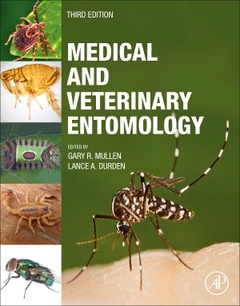Medical and Veterinary Entomology (3rd Ed.)
Coordonnateurs : Mullen Gary R., Durden Lance A.

1. Introduction 2. Morphological Adaptations of Parasitic Arthropods 3. Arthropod Toxins and Venoms 4. Epidemiology of Vector-Borne Diseases 5. Forensic Entomology 6. Cockroaches (Blattaria) 7. Lice (Phthiraptera) 8. True Bugs (Hemiptera) 9. Beetles (Coleoptera) 10. Fleas (Siphonaptera) 11. Flies (Diptera) 12. Phlebotomine Sand Flies and Moth Flies (Psychodidae) 13. Biting Midges (Ceratopogonidae) 14. Black Flies (Simuliidae) 15. Mosquitoes (Culicidae) 16. Horse Flies and Deer Flies (Tabanidae) 17. Muscid Flies (Muscidae) 18. Tsetse Flies (Glossinidae) 19. Myiasis (Muscoidea, Oestroidea) 20. Louse Flies, Keds, and Bat Flies (Hippoboscoidea) 21. Moths and Butterflies (Lepidoptera) 22. Ants, Wasps, and Bees (Hymenoptera) 23. Scorpions (Scorpiones) 24. Solpugids (Solifugae) 25. Spiders (Araneae) 26. Mites (Acari) 27. Ticks (Ixodida) 28. Molecular Tools Used in Medical and Veterinary Entomology Appendix: Arthropod-Related Viruses of Medical and Veterinary Importance
Upper-level undergraduate and graduate/postgraduate students are the primary audience for this textbook in association with accompanying courses in Medical Entomology, Veterinary Entomology, Medical and Veterinary Entomology, Public Health Entomology, Wildlife Entomology, Vector-Borne Diseases and Emerging Diseases. These courses are taught in various (mainly University) departments including those that specialize in Biology, Zoology, Entomology, Parasitology and Public Health. Students in Colleges of Medicine and Veterinary Medicine are another target audience as are practicing physicians, veterinarians, general entomologists, parasitologists, epidemiologists, and wildlife biologists.
Lance Durden is Professor of Vector Ecology and Curator of the Insect Collection in the Department of Biology at Georgia Southern University, Statesboro, USA. He earned a Ph.D. in Zoology from the University of London, UK and has worked at Vanderbilt School of Medicine in Nashville, Tennessee, the Smithsonian Institution in Washington DC, Auburn University in Alabama, and the U.S. Army Medical Research Institute of Infectious Diseases (USAMRIID) in Frederick, Maryland. He is the author or co-author of approximately 300 peer-reviewed publications including 24 book chapters and 7 books or monographs. His research focuses on ectoparasitic arthropods and vector-borne diseases.
- Completely revised and updated edition
- Includes a distinguished group of 40 nationally and internationally recognized contributors
- Sixteen new authors, in addition to 25 continuing contributors from the first and second editions
- A new chapter on Arthropod Toxins and Venoms
- Illustrated with 560, mostly color, figures and updated maps depicting the distribution of important arthropod taxa and arthropod-borne diseases
- A significantly expanded and well-illustrated chapter on Molecular Tools Used in Medical and Veterinary Entomology
- Coverage of emerging and newly recognized arthropod concerns, including mosquito-borne Zika and
- Chikungunya viruses; tick-borne Bourbon and Heartland viruses; tick-borne rickettsioses and anaplasmosis; and red meat allergy associated with tick bites
- A 1700-word Glossary
- An Appendix of Arthropod-Related Viruses of Medical and Veterinary Importance
Date de parution : 10-2018
Ouvrage de 792 p.
21.4x27.6 cm
Thèmes de Medical and Veterinary Entomology :
Mots-clés :
Arachnids; Acanthocephalans; Acariasis; Accumulated degree hours; Adaptation; Adult activity; African horse sickness; Allergy; Anaphylaxis; anaplasmosis; Androctonus; Ants; Apidae; Apis; Appendages; Argasidae; Arthropod; Arthropod-borne diseases; Asthma; bartonellosis; Bat bug; Bazaar fly; Bed bug; Bees; Biocontrol; Biting; Black flies; Black widow; Blattaria; Blattella; Blister beetles; Blood feeding; Blood-feeding; Bluetongue; Bombus; Bot fly; Brown recluse; Bumble bees; Buthidae; Calliphoridae; Camel-spider; Canine trypanosomiasis; Canthariasis; Cantharidin poisoning; Cantharidin; cat flea rickettsiosis; cat scratch disease; Centruroides; Chagas disease; Chagoma; Chewing lice; Chigger; Chrysops; Cimicid; Cockroach allergens; Contact dermatitis; Control methods; control; Control; Culicoides; cutaneous; Deathstalker; deer flies; Dermatitis; Diptera; Disease; Dolichovespula; Economic losses; elaeophorosis; Emerging infectious diseases



